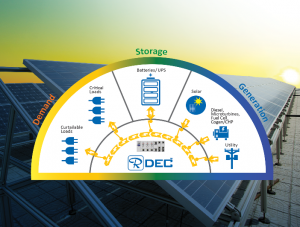
How to make distributed energy systems more sustainable
November 27, 2019
By Tim Kelley
Solar power with battery backup can mitigate traditional risks.

Image by Russelectric.
A continuous power supply is important to maintain commercial, industrial and health-care facilities in the event of a grid outage. Most of these distributed energy systems are powered by diesel generators, but companies looking to improve their sustainability are beginning to incorporate renewable sources. Options like solar power with battery backup can mitigate the risks of traditional backup power while also reducing environmental impact.
Mission-critical systems
Emergency backup power systems are designed to remain off during normal conditions, but kick in immediately when the grid-based power supply is lost. As such, typical facilities combine grid power with a diesel generator for emergency use only; but in some cases they use a co-generation/combined heat and power (CHP) generator to provide ongoing distributed energy. Controls are also needed to shut down non-critical loads during an outage.
While diesel generators are safe and reliable, (a) their energy costs are higher than solar energy’s zero marginal cost, (b) they produce emissions and may be subject to corresponding penalties if used too frequently outside emergencies and (c) they are subject to the risk of fuel unavailability in the event of a severe natural disaster, such as a flood or earthquake, which can prevent deliveries from replenishing diesel stores.
Portfolio diversification
For these reasons, it is worth considering renewable energy sources as part of a facility’s power generation portfolio.
While relying 100% on solar and battery-powered systems is theoretically possible, in most instances it would require more space than is available, due to the need to build a system large enough to produce enough electricity for use both when the sun is shining and when it is not.
It is more feasible to incorporate solar power and storage as far as space allows, to supplement traditional non-renewable energy. Facilities can then prioritize the use of lower-cost, cleaner solar power first, followed by co-generation or grid power and, finally, by diesel generation in an emergency.
Benefits and challenges
Since an on-site solar power generation and battery backup system is not dependent on the delivery of replenishments, it serves as ‘insurance’ against the risk of fuel interruption. It also allows diesel to be stored for longer periods for use in an emergency.
There are three main challenges to incorporating solar power and batteries into mission-critical systems.
The first is how to safely integrate intermittent generation sources without jeopardizing reliability. This challenge can be addressed with a well-designed distributed energy controller (DER).
The second is the amount of space required for a photovoltaic (PV) system. Many facilities have limited rooftop locations. This challenge can be addressed through creative siting, e.g. PV-covered parking canopies.
The third is related to cost. Some of the savings associated with solar power and battery storage relate to federal investment tax credits and accelerated depreciation, which can limit their use for some types of facilities. However, even not-for-profit organizations can harness the same cost benefits by leasing systems from system integrators.
Tim Kelley is director of renewable and storage solutions for Russelectric, a Siemens business.